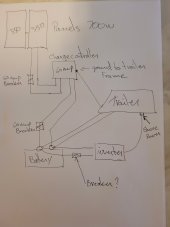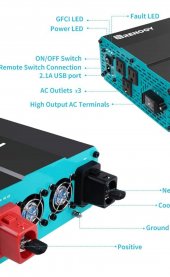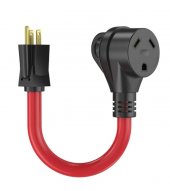Yeah, that works. The line from the inverter to shore power is to tie into the trailer's 120v AC side? If so, it may not be quite right.
Your breakers aren't quite right.
The breaker from the PV to the solar charge controller would need to be about 25 amps if the panels are wired in parallel. 15 amps if in series. This breaker is more of a switch than over current protection but it still needs to be sized right.
The breaker from the solar charge controller to the battery needs to be larger than 60 amps. Rated amps x 1.25 is what we recommend to avoid nuisance trips. Call it 75 amps.
Breakers that handle the number of amps an inverter can draw are expensive. Most installs use a fuse in that position. We like to see a Class T fuse immediately downstream of the battery on the positive leg.
Check out this diagram published by Victron Energy. It's overkill but it does a very good job of showing how a set of common bus bars, switches, fuses, batteries and devices get wired up.
Many inverters have an AC input port. The shore power cables (pos, neg, ground) will come into this port. The output of the inverter would then go to the main distribution panel of your trailer. Currently, the shore power cable goes into the main distribution panel. You'll disconnect the shore power cable from the main distribution panel and run it to the inverter instead. A new/longer cable may be necessary. My shore power cable came into an Automatic Transfer Switch (to switch between generator and shore power), so I replaced the cable that went from the ATS to the main distribution panel. The new cable goes from the ATS to the inverter. Another new cable of the same gauge goes from the inverter to main distribution panel.
If you don't have an on-board generator then you won't have an ATS. The inverter will have an internal ATS that keeps you from inverting 120v AC while the shore power circuit is also active (plugged into a pedestal).
The above leads into a discussion about the converter. An inverter like the Victron Multiplus is an inverter/charger and replaces the converter that your trailer came with. The OEM converter is probably not LiFePO4-friendly. Also, leaving it in place when implementing an inverter can lead to a loop. Battery -> Inverter -> Converter -> Battery






